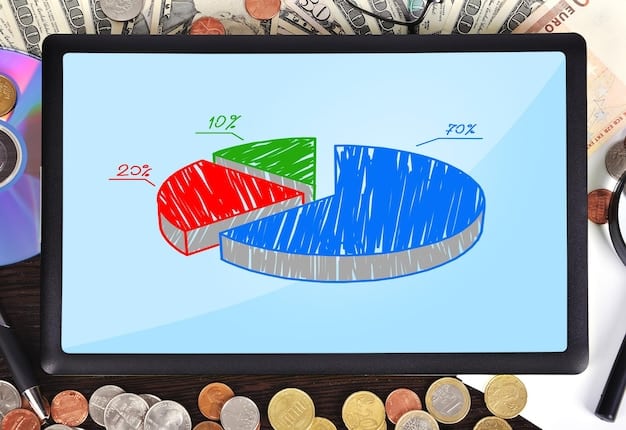Budgeting for Irregular Income: Strategies for Freelancers & Gig Workers

Budgeting for irregular income, a common challenge for freelancers and gig workers, requires adaptable strategies such as prioritizing needs, creating flexible budgets, and building emergency funds to navigate unpredictable earnings.
For freelancers and gig workers, income can feel like a rollercoaster. Mastering budgeting for irregular income is essential for financial stability and peace of mind. Let’s explore effective strategies to navigate this financial landscape.
Understanding Irregular Income and Its Challenges
Irregular income, characterized by inconsistent amounts and unpredictable timing, poses unique budgeting challenges. Unlike those with fixed salaries, freelancers and gig workers must proactively manage their finances to avoid financial instability.
The Nature of Irregular Income
Irregular income streams can vary significantly from month to month, making it difficult to plan for expenses. This variability often leads to stress and uncertainty about covering essential bills and savings goals.
Common Budgeting Pitfalls
Without a clear strategy, fluctuating income can lead to overspending during high-earning periods and struggling during lean times. Learning to smooth out income perceptions and manage cash flow effectively is key.
- Prioritizing needs over wants becomes crucial.
- Creating a flexible budget that adapts to income changes is essential.
- Building an emergency fund acts as a safety net during low-income periods.
Effectively managing irregular income requires a mindset shift from traditional budgeting practices to more adaptable and proactive strategies. This includes diligent tracking of income and expenses.

Creating a Flexible Budget
A flexible budget is designed to adapt to the ebbs and flows of irregular income. Instead of relying on fixed amounts, this approach allows you to adjust your spending based on your actual earnings.
Tracking Income and Expenses
The first step in creating a flexible budget is to meticulously track your income and expenses. Use budgeting apps, spreadsheets, or notebooks to monitor where your money is coming from and where it’s going.
Identifying Essential vs. Discretionary Expenses
Distinguish between essential expenses (rent, utilities, groceries) and discretionary expenses (dining out, entertainment). This distinction helps you prioritize spending and cut back on non-essential items during low-income periods.
- Categorizing expenses allows for better control.
- Reviewing spending habits helps identify areas for savings.
- Adjusting the budget based on income fluctuations ensures sustainability.
By understanding your income and expense patterns, you can create a budget that aligns with your financial realities, providing a roadmap for managing money effectively. Regular review and adjustments are essential.
Prioritizing Needs Over Wants
When dealing with irregular income, it’s crucial to differentiate between needs and wants. Prioritizing essential expenses ensures that your basic needs are met, even during periods of low earnings.
Assessing Essential Expenses
Identify essential expenses such as housing, food, transportation, and healthcare. Calculate the minimum amount required to cover these needs each month.
Cutting Back on Discretionary Spending
During lean times, reduce or eliminate discretionary spending on non-essential items. This might include dining out, entertainment, or subscriptions.
- Creating a list of needs versus wants helps clarify priorities.
- Setting spending limits on discretionary items prevents overspending.
- Finding alternatives to expensive habits saves money.
Prioritizing needs ensures financial stability despite fluctuating income. This disciplined approach helps you manage resources effectively and avoid unnecessary debt.
Building an Emergency Fund
An emergency fund is a critical component of financial security, especially for those with irregular income. It provides a safety net to cover unexpected expenses or income shortfalls.

Setting a Savings Goal
Determine how much you need in your emergency fund. A general guideline is to save three to six months’ worth of essential living expenses.
Automating Savings
Set up automatic transfers from your checking account to a savings account each month. Automating savings makes it easier to consistently build your emergency fund.
Strategies for Quick Savings
Consider cutting back on non-essential expenses and allocating the savings to your emergency fund. Small changes can add up over time, helping you reach your savings goal faster.
- Opening a high-yield savings account maximizes interest earned.
- Setting realistic savings goals ensures progress.
- Treating savings as a non-negotiable expense reinforces commitment.
An emergency fund provides peace of mind and protects against financial setbacks. It’s a vital buffer when income is unpredictable, preventing reliance on debt during emergencies.
Managing Taxes with Irregular Income
Freelancers and gig workers must proactively manage their taxes to avoid surprises during tax season. Planning and setting aside money for taxes throughout the year is essential.
Estimating Quarterly Taxes
Estimate your income and calculate your quarterly tax liability. The IRS provides resources and tools to help you determine how much you owe.
Setting Aside Money for Taxes
Each time you receive payment, set aside a percentage for taxes. A common guideline is to save 25-30% of your income to cover federal and state taxes.
Utilizing Tax Deductions
Take advantage of eligible tax deductions for business expenses, such as home office costs, equipment, and travel. Keeping accurate records of expenses helps simplify the tax filing process.
- Consulting with a tax professional ensures compliance.
- Using accounting software helps track income and expenses.
- Adjusting estimated tax payments based on income changes prevents underpayment penalties.
Proactive tax management ensures compliance and avoids financial stress during tax season. By planning ahead and utilizing available resources, freelancers and gig workers can navigate the complexities of self-employment taxes.
Leveraging Technology and Tools
Technology offers numerous tools and resources to help manage irregular income effectively. Budgeting apps, accounting software, and financial planning tools can streamline financial management.
Budgeting Apps and Software
Explore various budgeting apps and software that offer features such as income and expense tracking, budgeting templates, and financial reporting. Popular options include Mint, YNAB (You Need A Budget), and Personal Capital.
Accounting Software for Freelancers
Utilize accounting software like QuickBooks Self-Employed or FreshBooks to track income, expenses, and invoices. These tools help simplify bookkeeping and tax preparation.
Financial Planning Tools
Use financial planning tools to set goals, track progress, and manage investments. Many online platforms offer calculators, trackers, and educational resources to support financial planning.
- Choosing the right tools enhances efficiency.
- Integrating tools streamlines financial processes.
- Staying updated with the latest features maximizes benefits.
By leveraging technology, freelancers and gig workers can optimize financial management and make informed decisions. These tools provide valuable insights and support for navigating the challenges of irregular income.
| Key Point | Brief Description |
|---|---|
| 💰 Flexible Budget | Adapts to fluctuating income by adjusting expenses based on earnings. |
| ✅ Prioritize Needs | Focus on essential expenses like housing, food, and transportation. |
| 🛡️ Emergency Fund | Save 3-6 months of essential expenses for unexpected costs. |
| 🧾 Tax Planning | Set aside 25-30% of each payment for quarterly tax payments. |
FAQ
▼
Start by tracking your income and expenses for a few months to understand your financial patterns. Then, create a flexible budget that prioritizes essential needs and allows for adjustments based on your earnings each month.
▼
Start small. Even saving a few dollars each week can make a difference. Cut back on non-essential expenses and allocate those savings to your emergency fund. Over time, these small amounts will accumulate.
▼
Use the IRS Form 1040-ES to estimate your self-employment tax. Factor in your income, deductions, and credits. Review and adjust your estimates each quarter based on changes in your financial situation.
▼
Common deductions include home office expenses, business equipment, travel costs, and professional development fees. Keep detailed records of all eligible expenses to maximize your deductions and reduce your tax liability.
▼
Budgeting apps like Mint and YNAB (You Need A Budget) offer features tailored for flexible budgeting. Accounting software such as QuickBooks Self-Employed and FreshBooks can help track income and expenses, simplifying financial management.
Conclusion
Mastering budgeting for irregular income doesn’t have to be daunting. By implementing these strategies, freelancers and gig workers can achieve financial stability and peace of mind, even with fluctuating earnings. Embrace flexibility, prioritize needs, and leverage the available tools to gain control of your finances.





